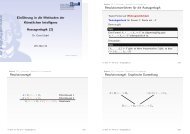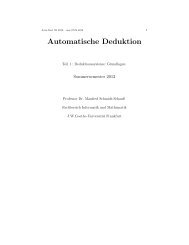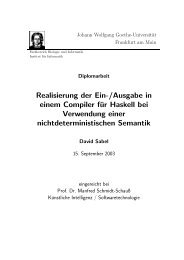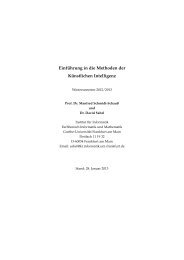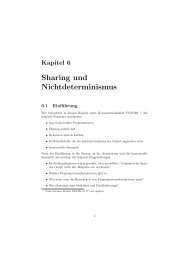Einführung in die Methoden der Künstlichen Intelligenz - Goethe ...
Einführung in die Methoden der Künstlichen Intelligenz - Goethe ...
Einführung in die Methoden der Künstlichen Intelligenz - Goethe ...
Erfolgreiche ePaper selbst erstellen
Machen Sie aus Ihren PDF Publikationen ein blätterbares Flipbook mit unserer einzigartigen Google optimierten e-Paper Software.
4 Prädikatenlogik<br />
Beispiel 4.2.7.<br />
σ = {x ↦→ a} σ(x) = a, σ(f(x, x)) = f(a, a)<br />
σ = {x ↦→ g(x)} σ(x) = g(x), σ(f(x, x)) = f(g(x), g(x)),<br />
σ(σ(x)) = g(g(x))<br />
σ = {x ↦→ y, y ↦→ a} σ(x) = y, σ(σ(x)) = a,<br />
σ(f(x, y)) = f(y, a)<br />
σ = {x ↦→ y, y ↦→ x} σ(x) = y, σ(f(x, y)) = f(y, x)<br />
Def<strong>in</strong>ition 4.2.8. Für e<strong>in</strong>e Substitution σ = {x 1 ↦→ t 1 , . . . , x n ↦→ t n } heißt<br />
dom(σ) := {x 1 , . . . , x n } <strong>die</strong> Doma<strong>in</strong><br />
cod(σ) := {t 1 , . . . , t n } <strong>die</strong> Codoma<strong>in</strong><br />
Gleichheit (modulo e<strong>in</strong>er Menge von Variablen W ) zwischen Substitutionen σ und τ wird folgen<strong>der</strong>maßen<br />
def<strong>in</strong>iert: σ = τ[W ] gdw. σx = τx für alle x ∈ W .<br />
E<strong>in</strong>e Instantiierungrelation ≤ [W ] zwischen Substitutionen σ und τ (für e<strong>in</strong>e Menge von<br />
Variablen W ) ist folgen<strong>der</strong>maßen def<strong>in</strong>iert:<br />
σ ≤ τ[W ] gdw. es existiert e<strong>in</strong>e Substitution λ mit λσ = τ[W ]. Zwei Substitutionen σ und<br />
τ s<strong>in</strong>d äquivalent, d.h. σ ≈ t[W ] gdw. σ ≤ τ[W ] und τ ≤ σ[W ] gilt.Ist W <strong>die</strong> Menge aller<br />
Variablen, so kann man W weglassen.<br />
Beispiel 4.2.9.<br />
Komposition:<br />
• {x ↦→ a}{y ↦→ b} = {x ↦→ a, y ↦→ b}<br />
• {y ↦→ b}{x ↦→ f(y)} = {x ↦→ f(b), y ↦→ b}<br />
• {x ↦→ b}{x ↦→ a} = {x ↦→ a}<br />
Instantiierungsrelation:<br />
• {x ↦→ y} ≤ {x ↦→ a}[x]<br />
• {x ↦→ y} ≤ {x ↦→ a}[x, y] gilt nicht !<br />
• {x ↦→ y} ≤ {x ↦→ a, y ↦→ a}<br />
• {x ↦→ f(x)} ≤ {x ↦→ f(a)}<br />
Äquivalenz: {x ↦→ y, y ↦→ x} ≈ Id (Id ist <strong>die</strong> identische Substitution)<br />
Def<strong>in</strong>ition 4.2.10. (Resolution mit Unifikation)<br />
Elternklausel 1: L, K 1 , . . . , K m σ ist e<strong>in</strong>e Substitution (Unifikator)<br />
Elternklausel 2: ¬L ′ , N 1 , . . . , N n σ(L) = σ(L ′ )<br />
Resolvente: σ(K 1 , . . . , K m , N 1 , . . . , N n )<br />
Stand: 25. November 2012 136 M. Schmidt-Schauß & D. Sabel, Skript KI, WS 2012/13



